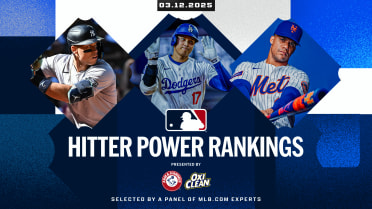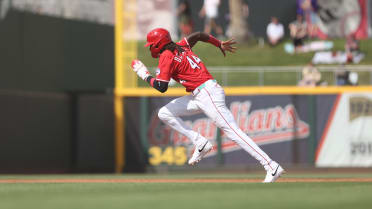How J.D. has improved despite slugging less
Red Sox star has third-largest OPS decline behind Ramirez, Carpenter
J.D. Martinez finished fourth in American League Most Valuable Player Award voting last year. He somehow managed to win 2018 Silver Slugger Awards at two positions -- it's weird, we know -- and he was one of the three best hitters in baseball from 2014-18. So even though his 2019 line of .309/.384/.475 is still quite good, by his standards, it feels like a step back.
And it is, sort of. There were 157 players who qualified for the batting title in 2018 and have also had at least 150 plate appearances in 2019, and only two have declined more in OPS than Martinez has. Jose Ramirez has lost 323 points of OPS. Then there's Matt Carpenter, down 226. Then there's Martinez, down .173 points from last year's 1.031 (third-best in baseball behind Mike Trout and Mookie Betts) to this year's .858. He just went 62 at-bats without a home run before going deep on Wednesday night in Baltimore.
That .858, again, is still solid. It's 28 percent better than league average. It's better than Ronald Acuna Jr., Justin Turner, or Bryce Harper. It's also worse than Martinez has had since 2013, his final year with Houston, before the Astros released him and he went through his well-documented swing and career rebirths.
As Martinez nears his 32nd birthday in August, you might think that this is the beginning of a soft decline phase. Maybe it is. But there's also evidence that Martinez is getting better, not worse. His strikeouts are way down. His ground balls are down. His underlying Statcast metrics are steady or up.
So what, exactly, is going on here?
* * *
Martinez slugged .629 last year, second-best in baseball. He slugged .690 in 2017, best in baseball among those with as many plate appearances as he had. These are established levels for him. This is what he does. So when you look at his Statcast numbers and see that his expected slugging percentage, based on the usual outcomes of his exit velocity and launch angle is .647, fourth-best in baseball, that tracks. It's right in character for him. If his actual slugging percentage was .647, you'd believe it.
You can see why. He's hitting the ball in the air (line drives and fly balls) more than he did last year, up to 57 percent of his batted balls from 53. When he hits those balls in the air, he's averaging 300 feet of distance, nearly identical to the 301 feet he had last year. On those liners and flies, 87 percent of them have been hard-hit, slightly better than last year's 84 percent.
Those are all good things. They're basically the same things he did last year, which is how you get to that "expected" number of .647 slugging, which is so very near 2018's actual slugging of .629.
Except if we leave the realm of "expected" his year, he's slugging only .475, which is 71st. That's a 172-point gap of missing slugging. It's the largest such gap in baseball. We need to find where that gap has gone. It's the key to understanding what's going on with Martinez.
Then you look at his home/road splits, and you realize that in some sense, it's not hard at all to see where that slugging has gone. It's gone to die in the deep center field triangle at Fenway Park.
Martinez home, 2019
.275/.321/.392
Martinez road, 2019
.330/.417/.523
That's a difference of 131 slugging points. It could be about worse production at home, but it's not. His hard-hit rate at home is 49 percent; his hard-hit rate on the road is 48 percent. His ground-ball rate at home (42 percent) is higher than on the road (38 percent), but not by much, and he's striking out less at home (13 percent) than on the road (16 percent). He has, considering quality of and amount of contact, been as good at home as he's been on the road.
The problem is that at Fenway Park, you can have things like this happen.
That's from April 12, when Martinez barreled up a ball at 107 mph and a 27 degree launch angle. It went a projected 410 feet. If you're wondering how often that kind of baseball becomes a home run, the answer is "basically all the time."
That's showing a generic field outline, not Fenway Park, but it helps get the point across: That ball should have been a home run. Since 2015, it basically has been more than 95 percent of the time, and the few rare times it hasn't been have been mostly extra-base hits to the deepest parts of deep ballparks in Detroit and San Francisco.
That's a big old "zero" on a ball probably worth 4.000 of slugging percentage, so you can see where some of that gap has gone. The worst part for Martinez is, it was the second day in a row this had happened. Here he is on April 11, crushing Joe Biagini for 106.8 mph worth of ... an out, thanks to Randal Grichuk.
That's another "zero" on a ball that's a home run nearly 90 percent of the time. (Among the other ones that didn't: Nelson Cruz hit the top of Target Field's 23-foot-tall right-field wall for a double, and Alex Rodriguez hit one off the side of the Green Monster. It's hard to do this and not homer.)
Here he is flying out to deep right field against the Blue Jays, a 102.1 mph/25 degree combination that's a hit 80 percent of the time and a home run 50 percent of the time. Here he is with a sacrifice fly against the A's, a 100.3 mph/31 degree combination that's a hit more than 55 percent of the time and a home run nearly 45 percent of the time.
It's not as simple as "bad luck," because this is the park that he plays in and he's hitting these high-value batted balls at the deepest parts of his park, but if you look at his highest-value outs, the top five have all come at home. Either way, only three hitters in the game have had more hard-hit balls -- the ones hit 95 mph or more -- turn into outs than Martinez has.
The point here is not to bemoan bad fortune, or to guarantee that his numbers will bounce back to their normal levels, because nothing is guaranteed, or even to say that Fenway Park is a bad fit, because in 2018, Martinez hit nine more homers with 110 extra points of slugging in the home whites. It's that there's different ways to get to "slow" starts. It would be one thing if Martinez was down 154 points of slugging because he couldn't hit for power anymore, or if he was pounding everything in the ground. He's not. He's hitting the ball just as well as ever. The underlying skills seem intact. Presumably he won't keep sending those high-value batted balls into the Fenway Park triangle all year long.
Again: Martinez has proven himself so elite that hitting .309/.384/.475 is somehow "a problem" here, and he's cut his 22.5 percent strikeout rate from last year into 14.5 percent this year, the sixth-largest strikeout decline -- or contact improvement, if you prefer -- in baseball. If you look at the underlying skills, in terms of quality of contact and amount of contact, Martinez has been baseball's fifth-best hitter, or exactly where he belongs.
The Red Sox, after a dreadful start, have proven themselves to be just fine lately. Martinez's start was hardly so dire, but all indicators point to him looking like himself too, soon.
Mike Petriello is a stats analyst for MLB.com, focusing on Statcast and Baseball Savant, and is also a contributor to MLB Network.




